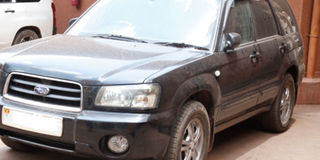Understanding the Subaru Forester II

Routine service parts for the Subaru are affordable but major replacement parts are pricy, but these are one offs and will last a long time if you don’t race the car on bad roads. Photo by Rachel mabala.
The Subaru Forester is a Cross Utility vehicle (CUV). This car segment competes with the larger, Sports Utility Vehicles (SUV) for the Ugandan used and new car market.
The Forester comes in four generations. The increasingly popular second generation Subaru Forester is built on the Impreza saloon car platform.
This works well with the weight saving hydro form sub frame and aluminum hood to make the vehicle lighter, more economical on fuel and nimble.
Forester II combines saloon car handling and comfort with attributes of an SUV or hatch back.
On the Ugandan used car market, the second generation 2.0 litre petrol turbo Subaru Forester is a popular choice for motorists who want to enjoy economy and a thrilling performance while they combine light off-road adventure with saloon-like comfort on the highway.
Performance
The generation II Subaru Forester comes with 2.0 litre or 2.5 litre turbo charged or non-turbo charged engines. The most popular is the EJ20T 2.0 litre petrol turbo charged engine, which uses 16 valves rocked by Double Overhead Camshafts.
The gratifying rumble in the Subaru Forester boxer engine when you step on the gas pedal is a confirmation of its enthusiastic response with 162 KW of engine power as its speedometer gauge reaches 100 KPH in 7.5 seconds.
Forester’s turbo charged flat boxer engine with horizontally positioned cylinders (moving sideways) has shorter cylinder stroke cycles. This blends well with the 16 valve DOHC drive train to accelerate with high power and torque curves. The Forester II has been designed with light aluminum panels in the bumper bar, bonnet, roof bars to make it more efficient.
Handling
The Forester II’s saloon like ‘unibody’ (chassis in body) construction with independent suspension ensures comfort and good handling as you will quickly notice that it is SUV tough and car easy. The suspension design features McPherson struts, coils and stabiliser bar on the front axle.
The rear axle is built with multi links, coil springs and stabiliser bars. This suspension matrix minimises body roll while the standard full time four wheel drive provides good road holding and stability during high speed maneuvers on the tight and winding highways.
Forester’s low slung H boxer engine and drag co-efficient of 0.35 gives it a good center of gravity and aero dynamism which enhance stability and an impressive response to changing dynamic forces. Forester’s suspension and design can handle light duty off road terrain suitable for the Ugandan upcountry and highway travel.
Styling, comfort and safety.
The Forester ii’s softer brick shape is not a striking beauty, however its fender flares and edges are more rounded and graceful compared to its first generation sibling.
Forester ii’s boxy bulging frontal outlook and lights project a bold and adventurous image which sits well on the brute force from its boxer engine as it respond to your call of duty.
Forester ii interior styling improves with a soft touch dimpled vinyl dash which blends well with the metal finish of the climate and radio controls.
The leg and seating room are ample and comfortable for five people, leaving enough load space. Features like air conditioning, electric windows and mirrors, CD Audio entertainment are available as a standard fit. The Forester ii has ANCAP car safety testing agency’s four stars for high safety standards.
Forester is built with a passenger safety cell, side intrusion beams front airbags and anti lock brakes with traction control to enhance driver control and car occupant safety.
Reliability and maintenance
The Forester ii is a reliable car if you inherit it with a good maintenance and user history. In case you buy one with more than 100,000 kilometers consider immediate replacement of the fuel filter and timing belt when you don’t have written evidence that they were carried out.
This will prevent expensive damage to the fuel pump and engine in the event of fuel filter and timing belt failure. Inspect or replace (where necessary) major suspension and steering linkage components, engine V belt and pulleys.
There is better availability of genuine parts at the local dealer and independent garages. But you need to look around. Routine service parts are affordable but major replacement parts are pricy, but these are one offs and will last a long time if you don’t race the car on bad roads.
Subaru recommend the 5W30 synthetic engine oil and higher octane petrol for better and longer engine protection and reduced engine cylinder knock to allow optimum performance. You can use Shell Helix Ultra fully synthetic oil. Shell V-Power is a high octane petrol.
Weighing scale
Subaru Forester
Year of manufacture 2002 - 2008
Engine size cubic capacity: 1,994, L4, DOHC 16V / 92/75
Engine power: 162KW@ 5,500 rpm
Max power RPM : 5500
Accerelation (0-100kph) sec: 7.5 seconds
Fuel economy (highway): 10km / Litre
Ground clearance mm 225
Cost price for used : Shs35m
Resale value: Shs13m




